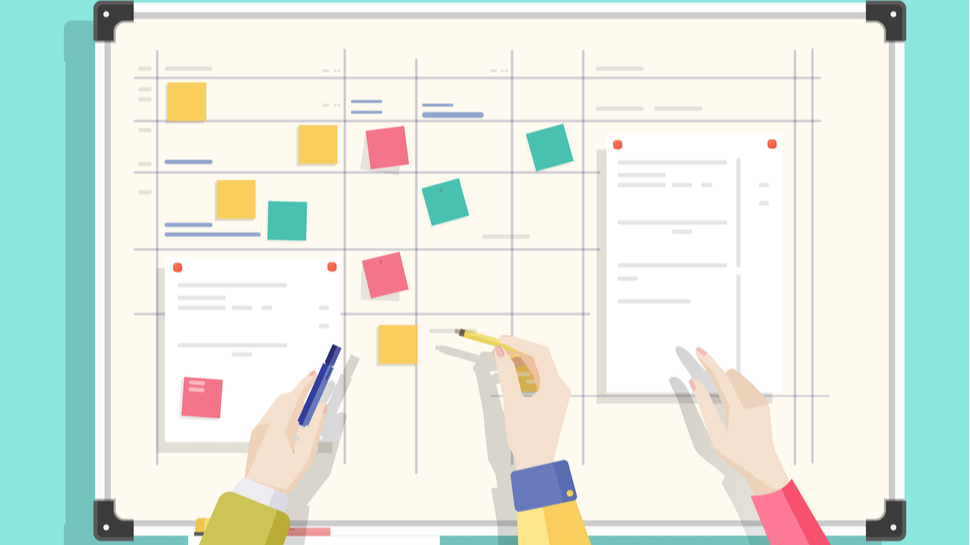Conference room whiteboards are an icon of the modern office, but these hallmarks of brainstorming have significant limitations. Scattered sticky notes are easy to misplace, dry erase markers refuse to function and teams quickly run out of room for their ideas. Early digital whiteboards, physical boards with interactive capabilities, still create bottlenecks in creativity as power lies in the hands of a single person at the board, rather than the collective group.
Today’s digital whiteboards are cloud-based, providing a virtual space for teams to brainstorm and organize ideas. Full teams can make contributions simultaneously, giving everyone a voice without the physical space limitations, creative bottlenecks, and handwritten piles of sticky notes.
About the author
Karl Sun is the co-founder and CEO of Lucid
Why use a digital whiteboard?
Digital, also called virtual or online, whiteboards have grown in popularity as remote work has surged. The current pandemic has forced teams to identify new ways to innovate, communicate and collaborate, making online productivity platforms, like virtual whiteboards, essential to daily work.
However, as companies plan for the future of their workforce, they need to remember that virtual whiteboard solutions don’t only solve issues with collaboration and productivity for remote work. These applications can be instrumental in maintaining efficient and effective collaboration as teams return to the office.
Digital whiteboards are a shared virtual space where teams can not only brainstorm together to create new ideas, but can also get on the same page to improve team alignment and create action plans. These applications enhance creativity and encourage innovation through features like freehand drawing, adding shapes and lines, and an infinite canvas, allowing teams to more easily generate ideas that drive the business forward. Meetings become more dynamic when team members can each share their voice, offering real-time thoughts and feedback for everything from creative solutions, shifts in a product roadmap, to even strategic planning for the new year.
What to look for in a digital whiteboard application
While there are multiple digital whiteboards available, you need to identify the solution that best balances the creative needs of your teams while maximizing productivity through quick and easy synthesis of ideas. Here are some features to consider as you evaluate the online whiteboard application for your team:
Facilitation
We’ve all sat through meetings that quickly lose focus. Facilitation tools within virtual whiteboards allow team leaders to effectively manage collaborative work while also inspiring creativity. You can easily share agendas within the whiteboard beforehand to ensure team members come prepared, and you can use timers to keep teams on task and maximize the time spent ideating, collecting feedback and identifying next steps. Use follow and presenter features that allow facilitators to help teams regroup and refocus on the right places within the virtual space. Facilitators can also leverage voting capabilities and comment features to quickly collect feedback and assign priorities. Many digital whiteboards also have the ability to invite guests outside of your known users to offer additional creative perspectives.
Collaboration
Real-time collaboration in digital whiteboards builds upon the benefits of in-person brainstorming while helping teams move as fast as they think. Adding sticky notes, drawings and shapes is quicker in a virtual format than on a physical whiteboard. And allowing participants to all work simultaneously provides more time for discussion and analysis. This also ensures everyone has a voice and shares their thoughts on the canvas before finalizing decisions. Additional helpful features to look for include things like assigned collaborator colors to track individual contributions and avenues for providing immediate feedback —like emoji reactions, comments and chat features — to keep people engaged and allow teams to more quickly align on priorities and next steps.
Virtual whiteboards also make asynchronous collaboration possible and effective. Team members can join shared whiteboards after a session, adding news ideas and offering commentary on their own time. Version histories make it possible to revisit older ideas, and even bring those who are unable to attend a meeting up to speed with a quick review of the board. Comments and notes should all be accessible through the single application, providing a central platform for teams to build off of and refer back to.
Organization
One of the greatest benefits of a digital whiteboard should be no longer having to spend hours combing through sticky notes, meeting minutes and emails. Instead, these solutions should make it easy for you to quickly organize and synthesize ideas so that your teams can move forward on action plans. Make sure your application allows for easy grouping and sorting using tags, colors, voting results, emojis and other criteria that make automatic sorting and synthesis possible. Manual or automatic templates and containers can also help users organize and categorize ideas, which enables team members to quickly visualize patterns and identify valuable new insights.
Action
Teams can leverage the analysis features of digital whiteboards to more easily identify and execute next steps. Using the right application, you can prioritize the organized ideas into clear action plans. Facilitators can use comments and tags to make assignments, and software integrations can easily transition those action items into existing workflows. Team members can then revisit and share the virtual whiteboard with the appropriate stakeholders to ensure project alignment across the business and over time.
As you look for ways to improve team collaboration and productivity, it’s important to remember virtual whiteboards can be an effective solution for remote and in-office work. These platforms inspire creativity, automate organization and quickly synthesize ideas, allowing teams to drive innovation without hours of administrative work. Spend time identifying which digital whiteboard best meets the needs of your team, and watch the sparks of creativity start to fly!





